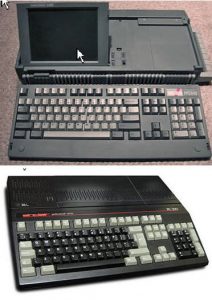Amstrad (P)PC personal computer family
After the successful 8-bit CPC series, Amstrad switched to producing 16-bit IBM PC-compatible personal computers in the 1990s; it first released portable versions, and then, after their success, launched desktop versions.
Below we describe the portable PPC 640 (top image, P64) and the less successful desktop PC20 (bottom image, P20) computers.
Use
Mainly intended for home use
Structure
Central unit
Word-organized machines: 16 bpW
- control unit:
- P64: NEC V30 microprocessor, clocked at 8 MHz
- P20: Intel 8086 microprocessor, clock speed 5 MHz,
- 16-bit internal and external bus system
- 20-bit external address bus system
- main store:
- P64: 640 KB RAM
- P20:
- 32 KB ROM
- calculator: ALU built into a microprocessor
- Intel 8087 math coprocessor (optional)
Periphery
- backups:
- P64: 2 floppy disks, 3.5″ 720 kB
- P20: 1 floppy disk, 3.5″ 720 kB
- external devices:
- P64: built-in monochrome LCD display
- P20: RF modulator for color (CGA) TV sets
- 102-key keyboard
- beeper
- couplers:
- P64: modem, 2400 baud
- RS-232 serial interface
- Centronics parallel interface
P64 power supply: 10*1.5 V alkaline batteries or AC adapter, 12 V operating voltage
Operation
The microprocessor is a compatible version of the Intel 8086.
Single and dual-address, non-orthogonal instruction set; fixed-point (with coprocessor + floating-point) instructions; direct and indirect addressing modes. One of the two factors was always loaded from main memory, the other could be a register content or a direct factor; the result was generated in the main memory factor location.
8 general registers (16 bits), four of which can also be used as 2*8 bits.
16 word stack, 256 interrupt levels, 32 KW reserved for B/K operations.
On the P64, an 8-switch DIP (dual in-line package) switch row could be used to set the built-in video circuit to emulate a CGA or MDA card, or to switch between the built-in or an external monitor.
Screen resolution:
- text mode: 25 lines, 40 | 80 chpl
- graphics mode: 320|640×200 pixels, monochrome or with external monitor 16|4 colors
Program set
- operating system: MS-DOS 3.3,
- P20: supplemented with GEM (Graphics Environment Manager) software package
- programnyelvek: assembly
- utilities:
- Organizer, resident editing assistant
- Mirror II, data transfer package
- internal-external monitor switch
P64: Game programs written for IBM PCs could be run with an external color monitor
P20: 4 game programs (CGA)
Historical curiosities
At the same time as the PPC 640, the PPC 512 computer with the same design was released, with 512 KB of RAM, no modem, and a lighter gray color.
The PC20 was also marketed as the Sinclair PC200, the former in a white and the latter in a black housing (as seen in the picture).
Resources
General description: PPC family (English)
General description: PC-20 (English)
More detailed technical data: PPC 640 (English)
Technical Manual: PPC Technical Manual (English)
Created: 2020.08.05. 22:47
Last modified: 2020.08.07. 16:24

